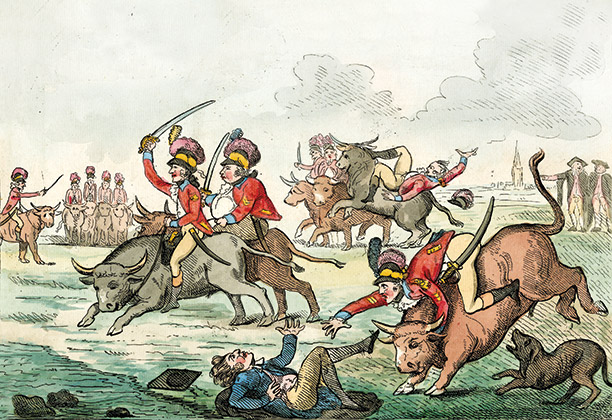Established partly in response to the long-feared
French invasion and partly to quell unrest at home, the yeomanry were
increasingly used by the authorities to intervene on the side of
employers in disputes and riots. The ensuing armed clashes present the
clearest example of class warfare in early 19th-century Britain, says
Nick Mansfield.
 'The Oxfordshire Cavalry Protecting their Beef', a 1794 print satirising the rural roots of the yeomanry.On
August 16th, 1819 a crowd of around 60,000 mainly working people
assembled on St Peter’s Field on the outskirts of the burgeoning
industrial town of Manchester. They had come to listen to the radical
leader Henry Hunt claim that the widespread economic depression since
the end of the Napoleonic Wars could be solved by parliamentary reform,
allocating MPs to new cities like Manchester and extending the right to
vote to working-class men.
'The Oxfordshire Cavalry Protecting their Beef', a 1794 print satirising the rural roots of the yeomanry.On
August 16th, 1819 a crowd of around 60,000 mainly working people
assembled on St Peter’s Field on the outskirts of the burgeoning
industrial town of Manchester. They had come to listen to the radical
leader Henry Hunt claim that the widespread economic depression since
the end of the Napoleonic Wars could be solved by parliamentary reform,
allocating MPs to new cities like Manchester and extending the right to
vote to working-class men.Hunt was a West Country squire who had himself served in the Marlborough Yeomanry, his local volunteer cavalry regiment, in the early 1800s. Before he was imprisoned for challenging his commanding officer to a duel, Hunt had accused his fellow troopers of ‘keeping up the price of corn, keeping down the price of wages and at the same time keeping in subjugation the labourers and silencing their dissatisfaction’.
The crowd at Peterloo did not hear Hunt’s famous oratory, as the Manchester and Salford Yeomanry stormed the rally in an attempt to execute a warrant for his arrest. The meeting disintegrated into chaos and bloodshed with, it is now thought, 18 civilian deaths and over 600 wounded. The fatalities included John Lees, a former regular soldier, who had served at Waterloo. The ill-trained part-timers of the yeomanry suffered mainly cuts and bruises.
Read the full text of this article in the current issue of History Today, which is out now in newsstands and on the digital edition for iPad, Android tablet or Kindle Fire.
No comments:
Post a Comment